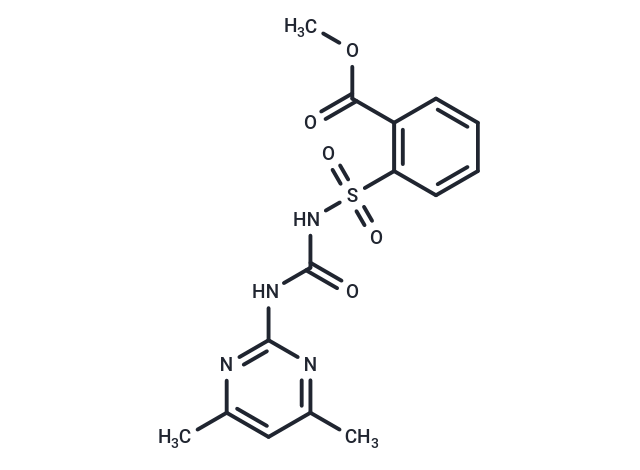Shopping Cart
- Remove All
 Your shopping cart is currently empty
Your shopping cart is currently empty

Sulfometuron-methyl (DXP-5648) is a herbicide and also is an active antibacterial agent. It is an effective inhibitor of acetolactate synthase II and thus shows antibacterial properties.

| Pack Size | Price | Availability | Quantity |
|---|---|---|---|
| 5 mg | $50 | In Stock | |
| 10 mg | $72 | In Stock | |
| 25 mg | $129 | In Stock | |
| 50 mg | $187 | In Stock | |
| 100 mg | $266 | In Stock | |
| 1 mL x 10 mM (in DMSO) | $67 | In Stock |
| Description | Sulfometuron-methyl (DXP-5648) is a herbicide and also is an active antibacterial agent. It is an effective inhibitor of acetolactate synthase II and thus shows antibacterial properties. |
| In vitro | The sulfonylurea herbicide sulfometuron methyl inhibits the growth of several bacterial species. In the presence of L-valine, sulfometuron methyl inhibits Salmonella typhimurium, this inhibition can be reversed by L-isoleucine. Reversal of growth retardation by L-isoleucine, accumulation of guanosine 5'-diphosphate 3'-diphosphate (magic spot), and relA mutant hypersensitivity suggest sulfometuron methyl interference with branched-chain amino acid biosynthesis. Growth inhibition of S. typhimurium is mediated by sulfometuron methyl's inhibition of acetolactate synthase, the first common enzyme in the branched-chain amino acid biosynthetic pathway. Sulfometuron methyl exhibits slow-binding inhibition of acetolactate synthase isozyme II from S. typhimurium with an initial Ki of 660 +/- 60 nM and a final, steady-state Ki of 65 +/- 25 nM. Inhibition of acetolactate synthase by sulfometuron methyl is substantially more rapid (10 times) in the presence of pyruvate with a maximal first-order rate constant for conversion from initial to final steady-state inhibition of 0.25 +/- 0.07 min-1 (minimal half-time of 2.8 min). Mutants of S. typhimurium able to grow in the presence of sulfometuron methyl were obtained. They have acetolactate synthase activity that is insensitive to sulfometuron methyl because of mutations in or near ilvG, the structural gene for acetolactate synthase isozyme II[2]. |
| Alias | DXP-5648, DXP5648, DXP 5648 |
| Molecular Weight | 364.38 |
| Formula | C15H16N4O5S |
| Cas No. | 74222-97-2 |
| Smiles | S(NC(NC=1N=C(C)C=C(C)N1)=O)(=O)(=O)C2=C(C(OC)=O)C=CC=C2 |
| Relative Density. | 1.48 g/cm3 |
| Storage | Powder: -20°C for 3 years | In solvent: -80°C for 1 year | Shipping with blue ice. | ||||||||||||||||||||||||||||||
| Solubility Information | DMSO: 18.33 mg/mL (50.3 mM), Sonication is recommended. | ||||||||||||||||||||||||||||||
Solution Preparation Table | |||||||||||||||||||||||||||||||
DMSO
| |||||||||||||||||||||||||||||||

Copyright © 2015-2025 TargetMol Chemicals Inc. All Rights Reserved.